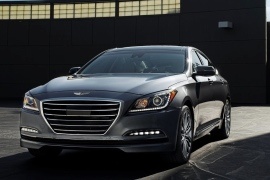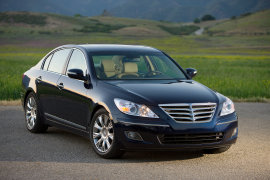HYUNDAI Genesis Models/Series Timeline, Specifications & Photos
First production year: 2008
Engines: Gasoline
The second generation of the Hyundai Genesis was introduced at the 2014 North American Auto Show in Detroit. The acclaimed premium sedan came with a long list of options and with more technology than before.
The Genesis was already moving towards becoming a separate premium brand for the Korean car-maker. The new generation stood out from the rest of the Hyundai range due to its very different design language. The 3D-hexagonal grille is depicted in semi-gloss chrome and includes the HID headlamps, LED turning lights and fog-lights. The taillights are full LED with a design like hexagonal-diamond cut.
Comfort is at high standards, due to the classic platform architecture, with the engine up-front and RWD, allowing a big wheelbase of 3010 mm (118.5 in). The total length of the car is 4990 mm (196.5 in). For the dashboard, the Hyundai Genesis utilizes a high-resolution TFT LCD technology, with a standard 4.3-inch TFT LCD cluster display. As an option, there is a 7.0-inch display available.
The base engine is 3.0-liter V6 gasoline with 257 hp and 304 Nm (224 lb.ft) of torque, while the top engine offered is a 5.0-liter V8 gasoline unit with a power of 420 hp and 520 Nm (383 lb.-ft) of torque. This sends its power either to the rear wheels or to an all-wheel-drive system via an 8-speed automatic transmission designed in-house by Hyundai.
Hyundai aimed higher with the Genesis lineup introduced in 2007 at the New York Auto Show, a car that marked the entrance into the premium segment for the Korean automaker.
Hyundai understood that a premium brand gets a better margin than a mass-market product, so it followed the same recipe used by Honda, Nissan, and Toyota when these Japanese brands launched Acura, Infiniti, and Lexus, respectively. Unlike these carmakers, Hyundai started from a blank sheet of paper and developed a completely new vehicle, starting from the platform and ending with the interior.
It was easy to see that the automaker's designers penned the Genesis with a clear inspiration from the German premium carmakers. The Mercedes-Benz-inspired headlights and the BMW 5 Series proportions of the bodywork led the Korean brand into a new, more conservative territory. At the front, the shield-like grille with rare horizontal slats and a vertical middle pillar looked intriguing.
While the design was not the strongest selling point of the Genesis, the interior was garnished with all the bells and whistles someone could ask from an upmarket automaker. From the power-everything (seats, windows, locks) to the standard USB port and iPod integration, the Genesis had them all. Thanks to the rear-wheel drive platform that led to a long wheelbase, the rear occupants had enough legroom while the headroom was not bad either.
For the drivetrain, the Hyundai opted for three options: either two V6s or a newly developed 4.6-liter V8, which sounded very appealing thanks to its uprated, four-pistons front brakes and larger rotors. Moreover, for selected markets, the Genesis also received a 5.0-liter V8. Unfortunately, the carmaker was not so experienced in building sports sedans, so the steering was not as sharp as the ones installed by its competitors.

